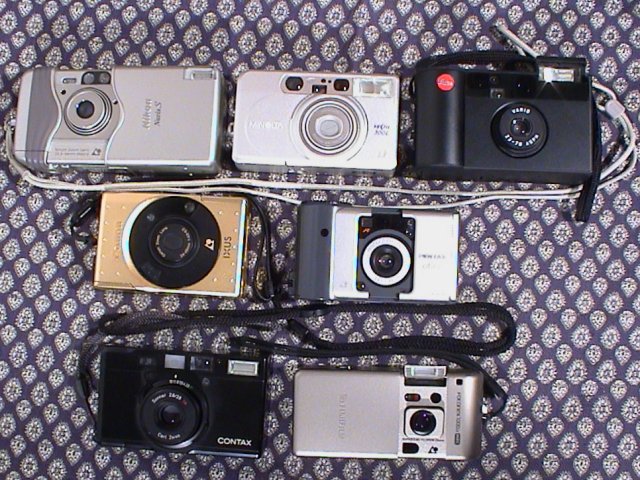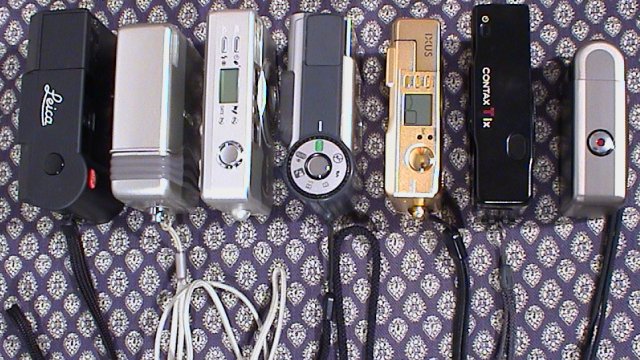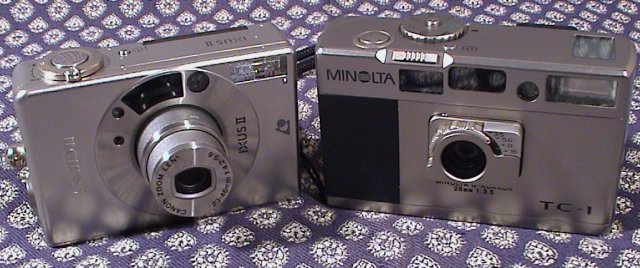In late 1991, Canon Inc., Fuji Photo Film Co., Ltd., Eastman Kodak Company, Minolta Co., Ltd., and Nikon Corporation (the "System Developing Companies") joined in a cooperative research and development venture to explore the possible technologies for a new photo system. This venture resulted in the Advanced Photo System, which was announced to the photofinishing trade at Photo and Imaging Expo in London, in October 1995, and to the industry as a whole at the Photo Marketing Association trade show in Las Vegas in February 1996.
In the first two years of the new format's debut in 1996/1997, all the other major film and camera manufacturers except Canon, had designed their APS compact cameras to be as large as their 35mm point & shoot versions, thus proving wrong any predictions for a truly compact camera system.

Top to bottom, left to right: Nikon Nuvis S, Minolta Vectis 30, Leica C11, Canon Ixus Gold, Pentax T, Contax TXi and Fujicolor 1000ix. The Nikon Nuvis and and Fujicolor have a shell that protects the camera's lens and controls when closed. The Nikon remains large, even closed. The Fujicolor is very small but lacks the zoom and in terms of volume only small gain over the Ixus 240. The Contax TXi is a solid, elegant camera, but also lacks a zoom, surprising for such a large camera in such company. The Minolta 300 has a x3 zoom and in a tiny package for features. Unfortunately there are too many reports of problems with the Vectis compact cameras and the zoom on this sample is not smooth.

Many APS cameras are now featured packed with automatic focus, automated film advance, zoom lens, date features and mid-roll film change. The reduced film size allows for a more compact camera than is possible with 35mm full frame cameras, although there are some 35mm cameras that are smaller than most APS cameras - see the tiny Canon Ixus II compared to the slightly larger Minolta TC-1 full size 35mm camera.

The APS (Advanced Photo System) format it is quite different to the “normal” 35mm film. The 24mm wide film itself comes in a self-contained cartridge which enables quick reloading. In order to load (or reload) the camera, you simply drop the cartridge into the slot, and close the cover. The film is perforated with two holes per frame and accompanied by a bar code which tells the printing machine the frame number (such codes are used on 35mm as well). The APS-specific transparent magnetic coating that carries the PQI information can't be seen, naturally. Many cameras sense the position of the film optically, using infrared LEDs to "see" the perforations. If you put a developed film (which is transparent, as opposed to an undeveloped one) into such a camera, it will generate an error message - the Elph/Ixus displays an "H", and has to be reset by removing and replacing the battery.
The film enables three different size of pictures to be taken (classic, wide-angle or panorama). All images are wide angle. To print a classic 2:3 (6x4") either side of the frame is cropped. For panorama the top and bottom are cropped. Prints have a standard 4" (10cm) height. Classic prints are 6X4", wide-angle (high definition 16:9) prints are 7x4" (17.7x10cm) and panorama are 10x4", (25.3x10cm). It is also possible to print any photograph in the other modes.
APS films is sold as 25 or 40 exposures. The developed
film is returned in the cartridge. The automated processing machines are able to
select the frame accurately and for prints to be made in any of the other
picture sizes. A standard size photograph is printed with thumbnail size views
of the negatives. The folder also has a reference number which matches up to the
film cartridge, meaning that if your film and folder ever get separated, you
still know which belongs to which. Each picture also has the reference number
printed on the back of it for easy identification.
The film cartridge also comes with an easy visual indicator to show whether the
film is exposed, processed, partially exposed and unused.
Processing of APS film has always been more expensive than standard 35mm. There are fewer choices of film with ISO 200 and ISO 400 being common but ISO 100 rare and black and white film harder to find. There are no slide films.
The APS processing equipment can be optimally set up for the film. Few operators do this as a matter of course. The gain in quality of the APS film material over 35mm film stock was soon eroded when it was loaded into 35mm cassettes and supplied as 120 film. Even the size gain was partly eroded as 35mm cameras gained the features of APS (like automatic loading and zoom lens) and reduced the size of the cameras.
The larger 35mm format (24x36mm compared to 16.7x30.2mm) means that prints need less enlarging and therefore typically show less grain. This is clearly seen if the same negative is printed in wide angle (H) mode and panorama (P) mode. Using only 9mm of the height of the negatives puts the negative into the realms of subminiature cameras using 10x14mm and 8x11mm negative size.
Few APS cameras include all the features of the standard for the format. In particular the recording of the aperture and shutter speed used for the photograph taken and the ability to change the film mid-roll and continue to use the film later are omitted.
By 2002 the format was already in decline. Compact 35mm have nearly all the features of APS and a significantly larger negative size. The next generation of digital cameras, such as the Canon Ixus II having reached 3.2Megapixels (launched May 2003) also having the advantage of instant gratification and effectively less grain on larger prints.
Many APS cameras come under the definition of subminiature using a film only 24mm wide, being under 4 inches in width and being designed with the intention that the camera is small enough never to be left behind.
Just as 110 shows what might have happened to 16mm cameras had the various formats survived APS show the next stage of development of subminiatures. The Minolta Vectis S-1 has the same outside dimensions as the Minolta SLR zoom Mk II and their head to head against the 35mm Minolta SLR 7Xi gives an insight into what these formats can do. It is however the Ixus II that epitomises the aim of APS in a fully automated zoom camera the size of a pack of playing cards.
| Wednesday, 26 December 2001 |

TOKYO (Reuters) - Japan's Minolta Co Ltd said on Wednesday it had halted new product development for APS (advanced photo system) cameras and would focus its resources on the fast-growing market for digital cameras.
The shift in business strategy is part of the camera and copier maker's effort to right itself by cutting costs and jobs after forecasting a group net loss of $160.4 million for the year through March.
Minolta lost 3.1 billion yen last year.
Investors welcomed the news, sending shares in Minolta up 8.39 percent to 155 yen on Wednesday morning. The Nikkei average dipped 0.1 percent.
APS standards were jointly developed by five camera makers -- Minolta, Nikon Corp, Canon Inc, Fuji Photo Film Co Ltd and Eastman Kodak Co
APS cameras were introduced in 1996 but the market for such products has been shrinking because of stiff competition from digital cameras.
A spokesman for Minolta said the firm, which entered the digital camera market in July, planned to expand its market share by assigning its APS researchers to digital camera
All material Copyright © 2004-2009 www.submin.com and the respective authors and contributors